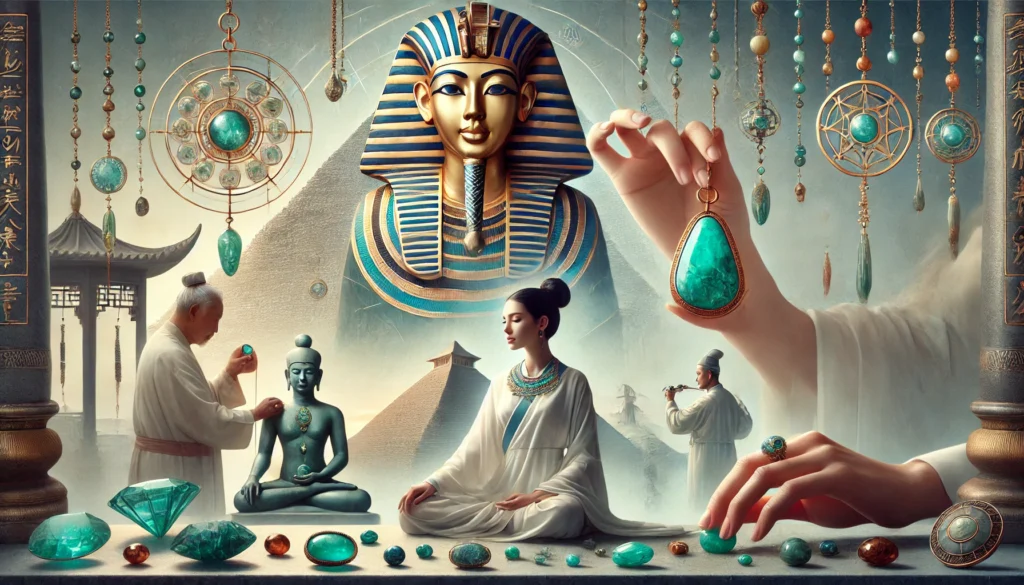
Jewellery has long been admired for its beauty and craftsmanship, but in ancient times, it held far more than just aesthetic value. Across various cultures, gemstones and jewellery were believed to possess healing properties and were integral to traditional medical practices.
Introduction
Imagine wearing a necklace not just for its charm, but for its believed power to cure ailments or protect against evil. Ancient cultures, from the Egyptians to the Chinese, imbued their jewellery with such significance. This article delves into the role of jewellery in ancient medical practices, highlighting the traditions of different cultures and the gemstones they revered.
The Egyptian Amulets: Symbols of Protection and Healing
The ancient Egyptians are renowned for their elaborate jewellery, which often served dual purposes as adornments and protective amulets. They believed that certain gemstones could ward off evil spirits and illnesses.
- Turquoise: Known as the “Gem of the Pharaohs,” turquoise was thought to bring good fortune and protect against harm. It was often inlaid in jewellery worn by both the living and the dead.
- Lapis Lazuli: Highly prized for its deep blue hue, lapis lazuli was associated with the heavens. It was believed to have healing properties, particularly for eye ailments.
- Carnelian: This reddish gemstone was thought to revitalise the body and provide energy. It was commonly used in amulets to protect the wearer in both life and death.
Chinese Jade: The Stone of Heaven
In ancient China, jade was more than just a beautiful stone; it was a symbol of health and immortality. Jade was often carved into intricate jewellery and talismans, believed to bring harmony and protect against diseases.
- Health and Longevity: Jade was thought to have a cooling effect on the body, helping to calm the mind and spirit. It was commonly used in bracelets and pendants.
- Protective Properties: Worn as an amulet, jade was believed to protect the wearer from physical harm and negative energy. It was also thought to bring good luck and prosperity.
Ayurvedic Gem Therapy in Ancient India
The ancient Indian system of Ayurveda incorporated gemstones into its holistic approach to health. Each gemstone was believed to resonate with specific energies and could balance the body’s doshas (vital energies).
- Ruby: Associated with the Sun, rubies were believed to enhance vitality and promote heart health. They were often worn in rings or pendants.
- Emerald: Connected to Mercury, emeralds were thought to improve mental clarity and communication. They were used to treat ailments related to the nervous system.
- Pearl: Symbolising the Moon, pearls were believed to have a calming effect and were used to treat emotional imbalances and digestive issues.
Greek and Roman Beliefs: Healing and Protection
The Greeks and Romans also attributed healing powers to gemstones and incorporated them into their medical practices. These ancient cultures left behind a wealth of knowledge on the therapeutic uses of jewellery.
- Amethyst: The Greeks believed that amethyst could prevent drunkenness and promote clarity of mind. It was often used in drinking vessels and worn as jewellery.
- Amber: Known for its warm, golden hue, amber was thought to have healing properties for respiratory issues and was commonly used in necklaces and amulets.
- Hematite: This iron-rich stone was believed to stop bleeding and was often worn by soldiers in battle for protection and strength.
Conclusion
The use of jewellery in ancient medical practices reveals a profound connection between beauty, spirituality, and health. Gemstones were not only prized for their aesthetic value but also for their believed ability to heal and protect. These ancient traditions remind us of the rich cultural heritage surrounding jewellery and its timeless allure.
From the protective amulets of ancient Egypt to the healing jade of China, jewellery’s role in traditional medicine highlights the deep-rooted human desire to find harmony between body and spirit. As we continue to admire and wear these beautiful pieces, it’s fascinating to reflect on their historical significance and the ancient beliefs that have shaped their enduring legacy.

